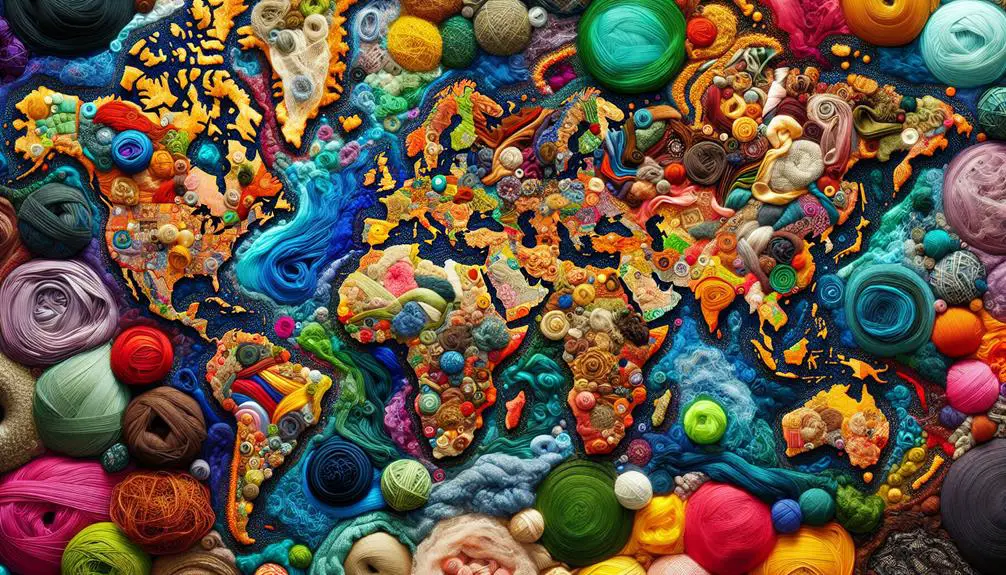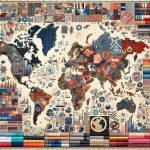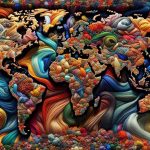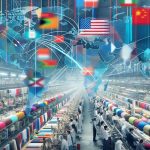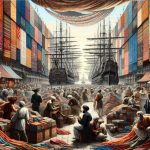You might not realize it, but fabric weaves its way through the very fabric of the global economy. It's not just about clothing; it's about jobs, trade, and technological advancements. The textile industry creates millions of jobs worldwide, influencing both local economies and international markets. As you consider the importance of sustainability and ethical production, you'll see how consumer preferences are reshaping this sector. How do these changes impact economic policies and global trade dynamics? The answers reveal much about our interconnected world and the future of economic growth.
Table of Contents
Key Takeaways
- The textile industry is a major global sector with a complex supply chain impacting economies worldwide.
- Fabric trade agreements and tariffs significantly influence market dynamics and fabric prices.
- Textile manufacturing was pivotal in the Industrial Revolution and continues to drive economic advancement in developing countries.
- Sustainable fabric production and technological innovations are transforming the industry towards eco-friendly practices.
- Smart textiles integrating sensors and electronics are creating new market opportunities and revolutionizing fabric functionality.
Historical Significance
Throughout history, fabric has often played a significant role in shaping cultures and economies. You can't overlook how textiles have woven themselves into the very fabric of societies. Consider the Silk Road, which wasn't just a trade route but a channel for cultural exchange. Through the movement of silk, you see how fabric facilitated the spread of ideas, religion, and art. This cultural influence is undeniable.
But it's not just culture that fabric has influenced—there's a strong economic component as well. You might think of the Industrial Revolution, where textile manufacturing was a cornerstone. The advent of mechanized looms and spinning jennies didn't just speed up production; they fueled economic development. Towns transformed into industrial hubs, generating employment and fostering economic growth.
Moreover, fabric has often been a symbol of wealth and status. In many cultures, the type of fabric one wore could signify social standing. This demand for luxury textiles spurred economic activities and international trade.
Textile Industry Overview
The textile industry stands as one of the largest and most dynamic sectors in the global economy. You'll find it's a complex network that influences virtually every corner of the world. The supply chain in textiles is intricate, involving everything from raw material procurement to manufacturing and distribution. Understanding this supply chain is essential if you aim to master the nuances of the industry.
Market trends are another pivotal aspect you need to grasp. Rapid changes in fashion, consumer preferences, and technological advancements drive these trends. For instance, sustainable fabrics and ethical production methods are gaining traction, reflecting a growing consumer awareness about environmental impact. Staying ahead in the textile industry means you've got to keep an eye on these trends.
Additionally, global economic shifts, trade policies, and geopolitical factors can greatly impact the textile market. Being adept at navigating these changes requires a keen understanding of how these elements affect both supply and demand.
Employment Impact
You can't overlook the significant impact the textile industry has on global employment. This sector is a powerhouse for job creation, employing millions worldwide. When you consider the entire supply chain—from raw material production to retail—you see how expansive and essential this industry is. Factories, small-scale workshops, and even home-based businesses all contribute to a diverse employment landscape.
In developing countries, the textile industry often serves as an essential stepping stone for economic advancement. Here, workforce development programs are pivotal. By offering specialized training and skill-building initiatives, the industry not only improves productivity but also enhances the quality of life for its workers. You see how this creates a ripple effect, boosting local economies and fostering community growth.
Moreover, don't underestimate the role of innovation in workforce development. Advanced technologies and sustainable practices are driving new opportunities for skilled labor. As you dive deeper into the sector, you'll notice how these advancements are reshaping traditional job roles and creating new ones.
In essence, the textile industry is more than just fabric and fashion; it's a crucial engine for job creation and workforce development on a global scale.
International Trade
You'll notice how trade agreements shape the fabric industry's global landscape, affecting tariffs and market access.
By understanding export-import dynamics, you can see how countries balance supply and demand.
These factors directly influence fabric prices and availability worldwide.
Trade Agreements Impact
Trade agreements significantly shape the flow of fabric across international borders, influencing global market dynamics. When countries negotiate these agreements, they set tariff rates that can either encourage or stifle the import and export of textiles. Lower tariffs can reduce costs for manufacturers, allowing for more competitive pricing and diverse fabric options for consumers. Conversely, high tariffs can lead to supply chain disruptions as businesses scramble to find cost-effective alternatives or absorb increased expenses, ultimately impacting the availability and price of fabric products.
You should understand that these agreements don't just affect prices; they also cause significant global market shifts. As tariffs change, countries may alter their textile production and export strategies, leading to new trade patterns. This can influence consumer preferences as different fabrics become more or less accessible. For example, a trade deal between two nations might make a specific type of silk more affordable, shifting consumer demand towards that product and away from more expensive alternatives.
In this intricate web of international trade, staying informed about trade agreements is vital for making strategic business decisions and anticipating market trends. By mastering these dynamics, you'll navigate the complexities of the global fabric market more effectively.
Export-Import Dynamics
Frequently, international trade in fabric hinges on the complex interplay of export-import dynamics that shape market accessibility and pricing. To master this domain, you need to understand how import-export trends and supply chain disruptions influence the global fabric market.
Here are three critical factors to note:
- Import Export Trends: Staying abreast of current import-export trends is crucial. Whether it's shifts in consumer preferences or geopolitical changes, these trends dictate which markets are lucrative and which aren't. For instance, an increase in eco-friendly fabric demand can open new markets.
- Supply Chain Disruptions: Supply chain disruptions can greatly affect the flow of fabric goods. Natural disasters, political instability, or pandemics can halt production and delay shipments, thereby impacting both supply and demand. Being prepared for such disruptions can mitigate risks.
- Government Policies: Tariffs, quotas, and trade agreements can either facilitate or hinder the seamless flow of fabric goods between countries. Understanding these policies allows you to navigate the complexities of international trade more effectively, optimizing your import-export strategy.
Economic Policies
Government economic policies profoundly influence the fabric industry's role in the global market. When governments intervene, they can stabilize or disrupt the supply chain, significantly impacting your business strategies.
For instance, tariffs and trade agreements dictate the cost and availability of raw materials, while subsidies can make local production more competitive. You need to stay informed about these policies to anticipate changes and adapt swiftly.
Furthermore, labor laws and environmental regulations can affect your operational costs and compliance requirements. Countries with stringent labor laws might see higher production costs, but they also offer a stable workforce, which can enhance productivity.
Conversely, lax environmental regulations might reduce immediate costs but could lead to long-term sustainability issues and reputational damage.
Tax incentives and grants are other forms of government intervention that can provide a financial cushion, allowing you to invest in new technologies or expand your operations. However, these benefits often come with strings attached, requiring meticulous adherence to guidelines and reporting standards.
Technological Innovations
In today's rapidly evolving market, technological innovations are reshaping the fabric industry in unprecedented ways. You're witnessing the rise of smart textiles, which are revolutionizing how fabrics interact with the environment and the wearer. These textiles aren't just passive materials anymore; they're becoming active participants in daily life, capable of monitoring health, regulating temperature, and even generating energy.
To truly master the landscape of fabric technology, consider the following:
- Smart Textiles: These advanced materials integrate sensors and electronics, enabling clothing to collect data and respond to changes in the environment. Think of garments that can track your heart rate or adjust insulation based on external temperatures.
- Innovative Processes: Cutting-edge manufacturing techniques such as 3D knitting and laser cutting are optimizing production efficiency. These methods reduce waste and allow for more customized designs, providing you with the ability to create highly specialized products.
- Digital Fabric & Tech Integration: The fusion of digital technology with textiles is opening new avenues for creativity and functionality. Digital printing on fabric allows for intricate designs and faster prototyping, while tech integration facilitates the creation of interactive textiles.
Environmental Considerations
When you consider fabric's impact on the environment, sustainable production and waste reduction are key areas to focus on.
By choosing eco-friendly materials and innovative recycling methods, you can greatly reduce the industry's carbon footprint.
Let's explore how these strategies are shaping a greener future for textiles.
Sustainable Fabric Production
Sustainable fabric production hinges on utilizing eco-conscious materials and processes to lessen the industry's environmental impact. By adopting eco-conscious factories and ethical sourcing, you can guarantee that the fabrics you produce or purchase are contributing positively to the planet.
It's essential to focus on the entire lifecycle of the fabric, from the origin of raw materials to manufacturing and finally, their end use.
One of the key aspects of sustainable fabric production is embracing the circular economy. In a circular economy, resources are continuously reused and recycled, minimizing waste and conserving natural resources. By supporting upcycling initiatives, you can transform waste materials into new, high-quality products, further extending their lifecycle and reducing environmental degradation.
To incorporate these practices effectively, consider these steps:
- Choose Eco-Friendly Factories: Ensure your production facilities use renewable energy, efficient water usage, and minimize harmful emissions.
- Ethical Sourcing: Select raw materials that are sustainably harvested and ethically produced to support fair labor practices and environmental stewardship.
- Embrace a Circular Economy: Implement upcycling initiatives to repurpose waste materials and create a closed-loop system that reduces the need for virgin resources.
Waste Reduction Strategies
Reducing waste in fabric production demands a comprehensive approach to minimize excess at every stage, from raw material sourcing to final product disposal. You need to employ recycling initiatives to repurpose scrap materials and reduce landfill waste. Implementing closed-loop systems ensures fabric remnants are reincorporated into new products. It's vital to work with suppliers who prioritize sustainable practices, allowing you to start with eco-friendly materials.
You can also leverage upcycling techniques, transforming discarded fabric into high-value items. This not only cuts waste but also creates unique products that appeal to environmentally-conscious consumers. Encouraging designers to think creatively about offcuts and surplus material can lead to innovative solutions, reducing your overall waste footprint.
To truly master waste reduction, integrate these strategies into your production processes. Consider establishing a zero-waste policy, where every scrap is accounted for and repurposed. Partner with organizations specializing in fabric recycling to handle any excess you can't use.
Frequently Asked Questions
How Does Fabric Innovation Influence Fashion Trends?
You'll see fabric innovation impact fashion evolution greatly. When new materials emerge, designers experiment, creating trends that redefine style. Stay informed about these advancements to master the ever-changing landscape of fashion.
What Are the Main Challenges Facing Modern Fabric Manufacturers?
You face significant challenges in modern fabric manufacturing, including supply chain disruptions and integrating automation technologies. Mastering these areas requires strategic planning and investment, ensuring your manufacturing process remains efficient and competitive in a global market.
How Does Fabric Quality Affect Consumer Purchasing Decisions?
Imagine you're choosing between two shirts: one with high fabric durability and low environmental impact, another with a lower price but questionable ethical sourcing. You'll likely opt for the former, valuing quality and sustainability over cost.
What Role Does Fabric Play in Sustainable Fashion?
In sustainable fashion, you prioritize eco-friendly textiles and ethical production practices. By choosing fabrics made from organic, recycled materials, and supporting fair labor, you contribute to reducing environmental impact and promoting ethical standards.
How Do Cultural Differences Impact Fabric Preferences?
You need to understand that cultural influences shape fabric preferences markedly. Different regions value various textures, patterns, and materials. Mastering these consumer preferences allows you to tailor your offerings to diverse markets effectively.
- How Does Ring Spun Cotton Affect Garment Fit and Shape Retention? - August 13, 2024
- What Are the Challenges in Producing Ring Spun Cotton? - August 13, 2024
- Is Ring Spun Cotton Suitable for Plus-Size Clothing? - August 13, 2024

